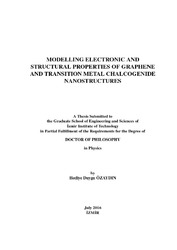Please use this identifier to cite or link to this item:
https://hdl.handle.net/11147/4843| Title: | Modelling Electronic and Structural Properties of Graphene and Transition Metal Chacogenide Nanostructures | Other Titles: | Grafen ve Geçiş Metali Kalkojenit Nanoyapılarının Elektronik ve Yapısal Özelliklerinin Modellenmesi | Authors: | Özaydın, Hediye Duygu | Advisors: | Senger, Ramazan Tuğrul | Keywords: | Two dimensional materials Hexagonal structures Monolayer Graphene Nanoribbon Transition metals VASP |
Publisher: | Izmir Institute of Technology | Source: | Özaydın, H. D. (2016). Modelling electronic and structural properties of graphene and transition metal chacogenide nanostructures. Unpublished doctoral dissertation, İzmir Institute of Technology, İzmir, Turkey | Abstract: | The purpose of this thesis is to investigate the electronic and structural properties of one- and two-dimensional materials such as graphene, graphene-like transition metal chalcogenides by using density functional theory. The single-atom thickness of graphene sheet is a novel material and attracts great interest due to its unique features. In recent years, theoretical and experimental studies on graphene provide quick knowledge and have opened up possibilities for many other two-dimensional new materials. Among these materials, especially transition metal chalcogenides have recently been the focus of studies of condensed matter physics. Unlike many superior properties of graphene, lack of band gap in electronic structure have highlighted the necessity of such transition metal chalcogenides materials for electronic applications. As compared to graphene, transition metal chalcogenides have various physical properties and possess sizable band gaps, for this reason they are promising candidate for many applications. Many experiments have revealed that the surfaces of graphene and graphene-like structures can play an active role as a host surface for clusterization of metal atoms. Motivated by these observations, we investigate characteristic properties of Pt atoms on graphene, MoS2 and TaS2. Similarly, TiSe2 is very recently synthesized two-dimensional transition metal dichalcogenide material and stable in 1T phase. Two-dimensional TiSe2 has a metallic electronic property and widely studied material. We analyze how to change the structural and electronic properties of TiSe2 by functionalization with hydrogen atom. Again to the effects of hydrogenation on two-dimensional TiSe2 monolayer we also study the structural and electronic properties of this material in nanoribbon form. At the same time, PtSe2 which is also very recently synthesized two-dimensional transition metal dichalcogenide and stable in 1T phase like TiSe2, its nanoribbon structural and electronic properties have also been investigated and compared with TiSe2 nanoribbons. Finally, TiS3 which is also transition metal chalcogenide but entirely different crystal structure, is recently widely studied materials. The structural and electronic properties as well as carrier mobility and strain response of TiS3 nanoribbons have been investigated. Besides many comprehensive theoretical studies, a lot of experimental studies are avaibale about the synthesis of these materials. In brief, these materials which tackles a contemporary and rapidly developing field, the nanoribbon form and functionalization of them that hold promise for many other applications. Bu tezin amacı, grafen ve benzeri geçiş metali kalkojenitlerin bir ve iki boyutlu nanoyapılarının elektronik ve yapısal özelliklerinin yoğunluk fonksiyoneli teorisi ile incelenmesidir. Tek atom kalınlığındaki grafen, bilinen ilk iki boyutlu nanomalzemedir ve benzersiz özellikleri nedeniyle oldukça ilgi çekmektedir. Son yıllarda yapılan grafen araştırmaları, gerek deneysel gerekse teorik olarak hızlı bir bilgi birikimi sağlayarak farklı birçok 2 boyutlu yeni malzemelerin de önünü açmıştır. Bu malzemeler arasında özellikle geçiş metali kalkojenitleri yakın zamanlarda yapılan yoğun madde fiziği araştırmalarının odağı olmuştur. Grafen malzemesinin birçok üstün özelliğine rağmen, bant aralığının olmayışı elektronik uygulamalarda geçiş metali kalkojenitleri gibi malzemelerin gerekliliği öne çıkarmıştır. Grafene kıyasla geçiş metali kalkojenitlerinin fiziksel özellikleri daha çeşitlidir ve yasak bant aralığının varlığı, pek çok elektronik uygulama alanı için umut vermektedir. Grafen ve benzeri yüzeylerde yapılan deneyler çeşitli metal atomlarının yüzeyde hızlı difüzyonlarının mümkün olduğunu ve bunların atom öbekleri oluşturma eğiliminde olduklarını ortaya koymuştur. Yaptığımız çalışmada Pt atomlarının grafen, MoS2 ve TaS2 üzerindeki karakteristik davranışları incelenmiştir. Benzer şekilde, TiSe2 malzemesi yeni sentezlenmiş iki boyutlu geçiş metali dikalkojenitidir ve 1T fazında metalik özellik gösteren bu malzeme oldukça fazla çalışılmıştır. Bu iki-boyutlu malzemenin hidrojen atomu ile fonksiyonelleştirdiğimizde yapısal ve elektronik özelliklerinin nasıl değiştiği araştırılmıştır. Yine bu malzemenin nanoşeritlerinin elektronik ve yapısal özellikleri ile, benzer 1T fazında ve yeni sentezlenmiş olan iki-boyutlu PtSe2 malzemesinin nanoşeritlerinin elektronik özellikleri kıyaslanmıştır. En son olarak da, geçiş metali kalkojeniti olan ama tamamen farklı kristal yapıya sahip ve son zamanlarda oldukça fazla çalışılan TiS3 malzemesinin, nanoşeritlerinin yapısal ve elektronik özelliklerinin yanısıra mobilite ve mekanik gerilim altında elektronik yapısının nasıl değiştiğine bakılmıştır. Teorik olarak yapılan kapsamlı birçok çalışmanın yanısıra deneysel olarak bu malzemelerin sentezi konusunda da çok fazla yeni çalışma mevcuttur. Kısacası, konusu güncel ve hızla gelişen bir alana giren bu malzemelerin nanoşeritleri ve işlevselleştirmeleri birçok uygulama alanı için umut vaad etmektedir. |
Description: | Thesis (Doctoral)--Izmir Institute of Technology, Physics, Izmir, 2016 Full text release delayed at author's request until 2019.09.29 Includes bibliographical references (leaves: 75-88) Text in English; Abstract: Turkish and English xiii, 88 leaves |
URI: | http://hdl.handle.net/11147/4843 |
| Appears in Collections: | Phd Degree / Doktora |
Files in This Item:
| File | Description | Size | Format | |
|---|---|---|---|---|
| T001496.pdf | DoctoralThesis | 16.52 MB | Adobe PDF |  View/Open |
CORE Recommender
Page view(s)
338
checked on Mar 31, 2025
Download(s)
166
checked on Mar 31, 2025
Google ScholarTM
Check
Items in GCRIS Repository are protected by copyright, with all rights reserved, unless otherwise indicated.